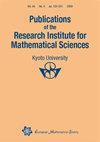Inter-universal Teichmüller Theory III: Canonical Splittings of the Log-Theta-Lattice
IF 0.7
2区 数学
Q1 MATHEMATICS
Publications of the Research Institute for Mathematical Sciences
Pub Date : 2021-03-04
DOI:10.4171/PRIMS/57-1-3
引用次数: 26
Abstract
The present paper constitutes the third paper in a series of four papers and may be regarded as the culmination of the abstract conceptual portion of the theory developed in the series. In the present paper, we study the theory surrounding the log-theta-lattice, a highly non-commutative two-dimensional diagram of “miniature models of conventional scheme theory”, called Θ±ellNF-Hodge theaters. Here, we recall that Θ±ellNF-Hodge theaters were associated, in the first paper of the series, to certain data, called initial Θ-data, that includes an elliptic curve EF over a number field F , together with a prime number l ≥ 5. Each arrow of the log-theta-lattice corresponds to a certain gluing operation between the Θ±ellNF-Hodge theaters in the domain and codomain of the arrow. The horizontal arrows of the log-theta-lattice are defined as certain versions of the “Θ-link” that was constructed, in the second paper of the series, by applying the theory of HodgeArakelov-theoretic evaluation — i.e., evaluation in the style of the scheme-theoretic Hodge-Arakelov theory established by the author in previous papers — of the [reciprocal of the l-th root of the] theta function at l-torsion points. In the present paper, we focus on the theory surrounding the log-link between Θ±ellNFHodge theaters. The log-link is obtained, roughly speaking, by applying, at each [say, for simplicity, nonarchimedean] valuation of the number field under consideration, the local p-adic logarithm. The significance of the log-link lies in the fact that it allows one to construct log-shells, i.e., roughly speaking, slightly adjusted forms of the image of the local units at the valuation under consideration via the local p-adic logarithm. The theory of log-shells was studied extensively in a previous paper by the author. The vertical arrows of the log-theta-lattice are given by the log-link. Consideration of various properties of the log-theta-lattice leads naturally to the establishment of multiradial algorithms for constructing “splitting monoids of logarithmic Gaussian procession monoids”. Here, we recall that “multiradial algorithms” are algorithms that make sense from the point of view of an “alien arithmetic holomorphic structure”, i.e., the ring/scheme structure of a Θ±ellNF-Hodge theater related to a given Θ±ellNF-Hodge theater by means of a non-ring/scheme-theoretic horizontal arrow of the log-theta-lattice. These logarithmic Gaussian procession monoids, or LGP-monoids, for short, may be thought of as the log-shell-theoretic versions of the Gaussian monoids that were studied in the second paper of the series. Finally, by applying these multiradial algorithms for splitting monoids of LGP-monoids, we obtain estimates for the log-volume of these LGP-monoids. Explicit computations of these estimates will be applied, in the fourth paper of the series, to derive various diophantine results. Typeset by AMS-TEX 1 2 SHINICHI MOCHIZUKI泛域间的teichmller理论III:对数格的正则分裂
本论文是四篇系列论文中的第三篇,可以看作是该系列中发展的理论的抽象概念部分的高潮。在本文中,我们研究了关于log-theta-lattice的理论,这是一种高度非交换的二维图,称为Θ±ellNF-Hodge剧院。在这里,我们回顾一下Θ±ellNF-Hodge影院,在该系列的第一篇论文中,与某些数据相关联,称为初始Θ-data,其中包括数字域F上的椭圆曲线EF,以及素数1≥5。对数晶格的每个箭头对应于箭头的域和上域的Θ±ellNF-Hodge剧院之间的某种粘合操作。log-theta晶格的水平箭头被定义为“Θ-link”的某些版本,该版本是在本系列的第二篇论文中,通过应用hodgearakelov理论评估理论-即,以作者在前几篇论文中建立的方案理论Hodge-Arakelov理论的风格评估-在l-扭转点上的函数的[第l根的倒数]。在本文中,我们将重点关注Θ±ellNFHodge剧院之间的日志链接理论。粗略地说,log-link是通过在考虑的数字域的每个[简单地说,非阿基米德]估值中应用局部p进对数而获得的。日志链接的意义在于,它允许人们构建日志壳,即,粗略地说,通过局部p进对数,在考虑的估值处对局部单元的图像进行稍微调整的形式。作者在以前的一篇论文中对圆木壳理论进行了广泛的研究。log-theta-lattice的垂直箭头由log-link给出。考虑到对数格的各种性质,自然建立了构造“对数高斯处理一元群的分裂一元群”的多径向算法。这里,我们回顾一下,“多径向算法”是从“异形算法全纯结构”的角度来看有意义的算法,即Θ±ellNF-Hodge剧院的环/图式结构与给定的Θ±ellNF-Hodge剧院通过对数晶格的非环/图式理论水平箭头相关联。这些对数高斯处理monoids,或简称LGP-monoids,可以被认为是本系列第二篇论文中研究的高斯monoids的对数壳理论版本。最后,将这些多径向算法应用于LGP-monoids的分割,得到了这些LGP-monoids的对数体积估计。在本系列的第四篇论文中,将应用这些估计的显式计算来推导各种丢番图结果。由AMS-TEX 12望月新一排版
本文章由计算机程序翻译,如有差异,请以英文原文为准。
求助全文
约1分钟内获得全文
求助全文
来源期刊
CiteScore
1.90
自引率
0.00%
发文量
26
审稿时长
>12 weeks
期刊介绍:
The aim of the Publications of the Research Institute for Mathematical Sciences (PRIMS) is to publish original research papers in the mathematical sciences.

 求助内容:
求助内容: 应助结果提醒方式:
应助结果提醒方式:


